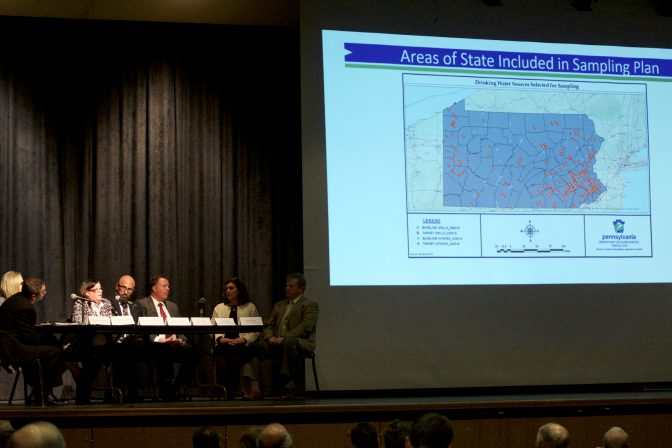
Representatives from the state's PFAS Action Team updated people on plans for water testing during a meeting in Abington, Pa, on April 15, 2019.
Bastiaan Slabbers / for WHYY


Representatives from the state's PFAS Action Team updated people on plans for water testing during a meeting in Abington, Pa, on April 15, 2019.
Bastiaan Slabbers / for WHYY

Bastiaan Slabbers / for WHYY
Representatives from the state's PFAS Action Team updated people on plans for water testing during a meeting in Abington, Pa, on April 15, 2019.
Gov. Tom Wolf’s PFAS Action Team met with residents in Abington, Pa. on Monday to update them on plans to test water sources across the state for contamination by a toxic class of chemicals known as PFAS.
But many residents expressed frustration at a regulatory process they say is taking too long.
Environmental regulators expanded on an announcement from last week that the state will begin sampling 400 sites across the state for six PFAS chemicals — including PFOA, PFOS, and PFNA — to see where the chemicals appear and in what concentrations. The chemicals have been used in products including firefighting foam, non-stick cookware, and stainproof textiles.
The Department of Environmental protection will sample 360 public water sources and 40 other sites in more remote areas that will serve as controls. The department will focus its sampling efforts near sites that either used or manufactured PFAS, including airports, military bases, and manufacturing facilities. In the control group, state scientists will analyze half for groundwater levels and half for surface water.
In the first phase of the sampling plan, the DEP will sample water sources for about a year, though officials could not specify what the second phase would entail.
“The primary purpose of what we’re doing is to look for prevalence of the chemical across the state,” said DEP Secretary Patrick McDonnell. “Obviously if we’re finding incidence of the chemical above the current health advisory limit, we’ll be taking appropriate actions there.”

Bastiaan Slabbers / for WHYY
People at a community meeting in Abington, Pa. on April 15 got an update of where the state will test drinking water for levels of the toxic family of chemicals known as PFAS.
The information, he said, will be critical in developing a PFAS drinking water standard, also known as a maximum contaminant level or MCL, which the state has pledged to do in the absence of federal regulatory action.
McDonnell said developing an MCL — the state’s first — would take about two years, given the regulatory requirements of doing so.
But Jill Florin of Upper Dublin said she’s disappointed that the state isn’t moving faster.
“The fact that [McDonnell] said that it’s going to take years to get an MCL is ridiculous when other states have stepped up and are in the process of getting MCLs immediately,” she said.
Southeastern Pennsylvania has been particularly hard hit by PFAS contamination because three former military bases there used PFAS-laced firefighting foam, which seeped into groundwater and contaminated drinking water supplies.
“We are here tonight in southeastern Pennsylvania specifically because we know this area has been impacted like nowhere else in the commonwealth,” McDonnell said at the meeting at Abington Senior High School, which is less than 10 miles from the former bases in Horsham and Willow Grove.
At the meeting, state health officials also announced the continuation of pilot study that looked at blood samples from exposed residents in Bucks and Montgomery counties. That study found elevated levels of PFAS in the blood serum of the 235 residents it surveyed.
Now, the health department will collect urine, dust and water samples from those residents to try to better understand the health effects and routes of exposure.
State Epidemiologist Sharon Watkins said the Department of Health is continuing to analyze the blood samples taken last year and, in a multivariate analysis, has concluded that higher blood PFAS levels were correlated with a person’s drinking water source.
“Even considering all other things,” Watkins said, “it did matter which public water system you were getting your drinking water from.”
The highest serum PFAS levels were found in those who received their water from the Horsham Water and Sewer Authority, which is closest to the Horsham Air Guard Station. The lowest levels were found in North Wales and Warrington Township – the farthest from the bases.
The Department of Health will hold a meeting April 29 in Horsham to discuss that analysis in more detail.
The lack of regulatory action at the state or federal level has also frustrated local utilities, who find themselves caught between concerned customers and an unenforceable federal health advisory.
“It puts water suppliers in a limbo,” said Chris Crockett, chief environmental officer at Aqua Pennsylvania, “such that you’re not sure if you need to do more, or if you’ve already done too much. And so your customers don’t have a clear understanding of, is that water good enough for them, or not? And you need a clear standard to answer that question.”
Aqua has been monitoring PFAS levels in its drinking water supplies since 2016 and has taken four systems offline. Two have treatment installed, a third will have treatment running in May, and a fourth has begun pilot project studying ion exchange as a potential treatment option.
In addition, the company has added large amounts of activated carbon powder to water supplies at their Neshaminy treatment plant, whose water source receives contaminated water from the Willow Grove base.
“Even within the last several months, the levels leaving that base have been up to 100 times the health advisory limit,” Crockett said.
Many residents and local officials pointed fingers at the military for not doing enough to remediate the contamination and sticking them with the bill.
“Horsham residents should not have to pay for this,” said Danette Richards of Horsham. “We didn’t ask for this. We had nothing to do with this.”
Bill Watkins, Horsham’s Township Manager, said what the community really wants is less talk from the PFAS Action Team and more action.
“We’re getting tired of the meetings,” he said. “We’re getting tired of repeating ourselves. We understand that these meetings must take place, but in the meantime any action – some type of action – we would like to see.”
StateImpact Pennsylvania is a collaboration among WITF, WHYY, and the Allegheny Front. Reporters Reid Frazier, Rachel McDevitt and Susan Phillips cover the commonwealth’s energy economy. Read their reports on this site, and hear them on public radio stations across Pennsylvania.
(listed by story count)
StateImpact Pennsylvania is a collaboration among WITF, WHYY, and the Allegheny Front. Reporters Reid Frazier, Rachel McDevitt and Susan Phillips cover the commonwealth’s energy economy. Read their reports on this site, and hear them on public radio stations across Pennsylvania.
Climate Solutions, a collaboration of news organizations, educational institutions and a theater company, uses engagement, education and storytelling to help central Pennsylvanians toward climate change literacy, resilience and adaptation. Our work will amplify how people are finding solutions to the challenges presented by a warming world.